
Background information
Lenses without autofocus: what can you use them for?
by David Lee

Professional photographer Mathias Kniepeiss shows me how he works and hands over the camera. I’m learning a lot – including that certain shots require a lot of practice.
Three freestyle mountain bikers, a professional photographer and lots of photo equipment provided by Sony: I should be all set up to take spectacular pictures. We’re at the SKILLS PARK in Winterthur, a large indoor sports facility with a range of different tracks.
Mathias Kniepeiss is a Sony ambassador, and the manufacturer organised today’s shoot. However, this article isn’t going to be publicity for Sony. I took part because I want to gain expertise and pass it on. This afternoon, I’m going to see up close how Mathias works and have a go myself. It’s all about getting a feel for how this type of action photography works.
First, let’s take a closer look at the location. The lighting conditions aren’t ideal: it’s relatively dark in the hall on cloudy days, and the light is a mix of daylight and artificial light. Artificial light combined with the electronic shutter can lead to streaking, but the electronic shutter would be better because it enables a higher continuous shooting speed. We take a few test shots. It turns out that daylight is the dominant element. We opt for the electronic shutter for the Sony Alpha 9 II.
The Skills Park offers multiple facilities for anything with wheels: bowl, jump park, big air, mini ramp, concrete street park, pump track. Got that? I haven’t. Mathias thinks we should try several different areas. Sounds good to me. He also discusses the location with the three bikers, Lucas, Jan and Vincent. That’s important, Mathias stresses – the riders have to say what works for them and what doesn’t.
First, the three guys head to the big ski jump. Mathias and I take photos with a wide-angle lens from side-on. The difference between our first pictures is that, in his shots, the airborne bikers are sharp, whereas they’re not in mine.
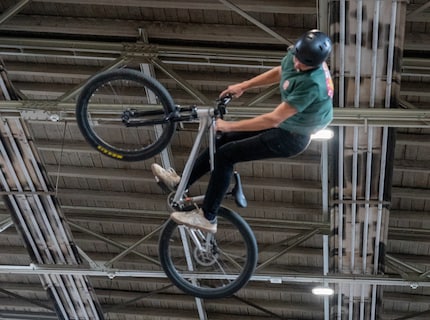
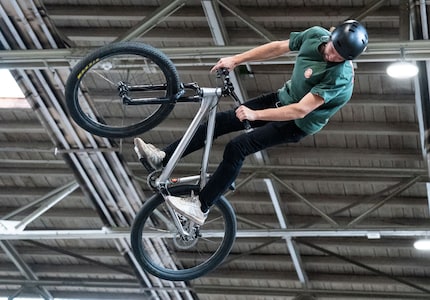
Mathias set the autofocus correctly for me, but I’m not used to taking photos like this. I usually use automatic eye, face or body recognition, but that doesn’t work here because the jump is much too fast. We’re right on the ramp, the whole movement is very close and the subject changes completely in a split second.
This means that we have a fixed rectangle in the middle as the focus field. I have to guide the camera in such a way that the rider is in the focus field. This is harder than it sounds. It only works if I follow the movement before I even see the biker. Once he’s in the frame, I have to press halfway and then all the way down. Since the movement is an irregular arc, only the hall ceiling remains sharp for me. I have to get used to looking at the screen instead of through the viewfinder. Big movements are easier to follow this way, and I have a better view of the surroundings.
After 200 discarded photos, I’m finally improving, but we changed our position ages ago. We’re now on the landing mat and the guys are jumping over us.
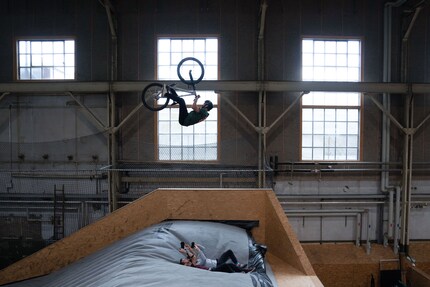
It was Mathias’ idea. He also likes to try out positions that aren’t totally without risk to get an extraordinary perspective. I don’t have to do it if I don’t want to, he assures me. After a moment's hesitation, I join him. After seeing the kind of jumps that Lucas, Jan and Vincent can pull off, I can’t imagine them accidentally landing on us. They’re too good for that. Mathias works with the riders to make sure that no children jump while we’re on the mat and makes sure that a Sony employee takes pictures of us in the thick of the action. I notice that he always keeps track of the big picture.
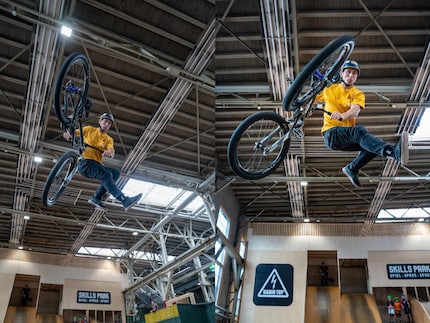
Here are two photos taken from the mat with the 24–70 mm GM II. The composition of the image isn’t perfect compared to Mathias’ shot, but at least the subject is in focus this time. The sequence of movements is also less complex here than from the side.
Now let’s switch to a telephoto lens. Opting for the 70-200 mm GM2 lens, we stand at the end of the landing mat and try out some different angles. I produce much sharper images this way. For a moment, I think I’ve got things under control. But Mathias destroys my illusions: movements are generally easier to follow from afar than from up close.
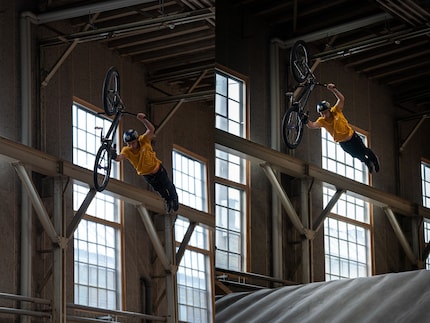
One problem remains: the light. Not only is there not much of it, it’s also coming from the wrong side. From side-on, the riders are flying through the air right in front of windows.
Next, the three bikers leap and weave through the bowl. The Bowl Park consists of several interconnected bowls.
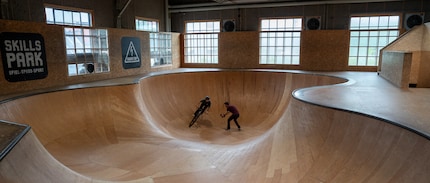
Mathias shoots from barely a metre away with an ultra-wide angle lens. Meanwhile, I test out various other locations, but nothing works. I quickly realise that where the bikers ride has to be precisely coordinated with the photographer. Being a casual observer doesn’t cut it.
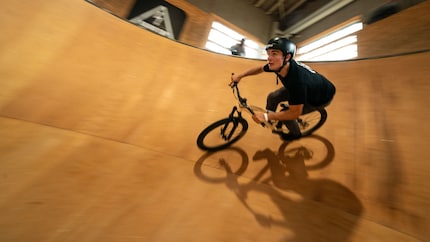
After a short while, Mathias lets me have a go. Like him, I stand in the middle of the floor, but in a place where the riders change to another circuit. I’m startled because they’re whizzing past so close to me. They don’t fit into the shot from the shortest distance, despite the ultra-wide angle.
It’s a pity that the face isn’t sharp here, otherwise it would have been a really good picture.
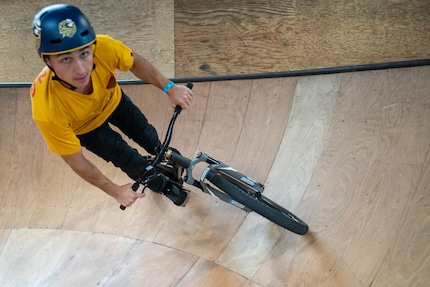
Mathias raves about Sony’s 50 mm f/1.2 lens. That’s what we use in the Jump Park, an area with a range of smaller jumps. I wonder whether the depth of field is big enough – especially considering that I’m still finding focusing difficult.
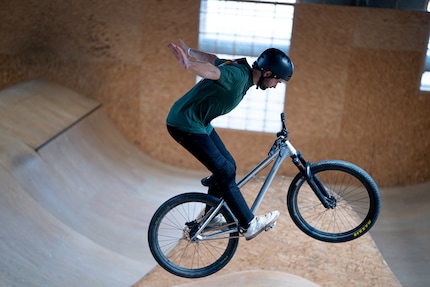
The shallow depth of field you get with f/1.2 is enough for shooting in profile. In fact, it’s an advantage, as it softens the background nicely. Another advantage of the large aperture is that, at 640, the ISO sensitivity is much lower than with many other shots this afternoon.
But taking shots from side-on is also difficult – you have such little time. I was lucky that the shot with the best pose is also sharp. Other shots from this position have a slight motion blur or, once again, the wrong focus.
Mathias is now standing right under the first jump, against the wall. I think it’s there for security reasons, but no. The biker’s supposed to jump against the wall, and Mathias stands directly underneath to photograph him up close.
I have a go myself. I get a fright the first time, because I only see the rider when he’s already on the wall about two metres away from me. My subsequent attempts no longer scare me, but it’s difficult to react fast enough. It’s also really dark in the park at this point.
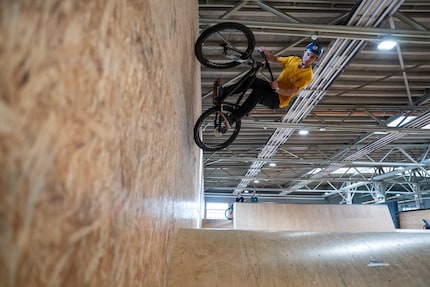
At the very end, Mathias shoots a series of portraits. This is where I get the clearest view of his routine. He immediately has several ideas: a portrait with the bike parked up, pulling a face through the front wheel, leaning against the reflective window. His instructions are short and precise without creating any stress. In less than 10 minutes, Mathias had snapped portraits of all three riders.
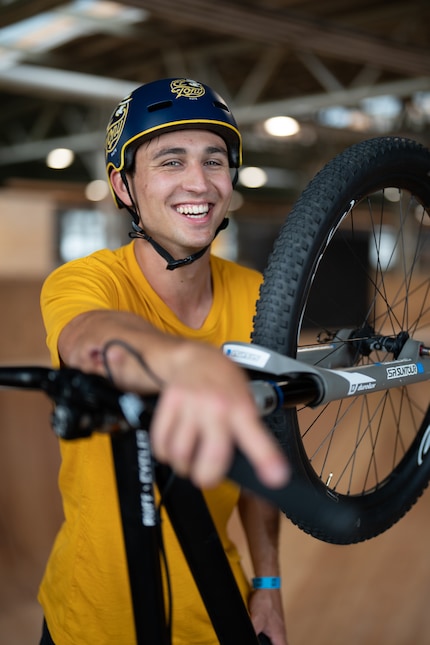
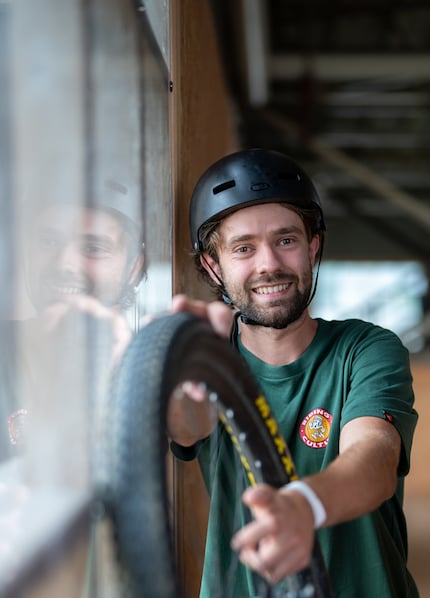
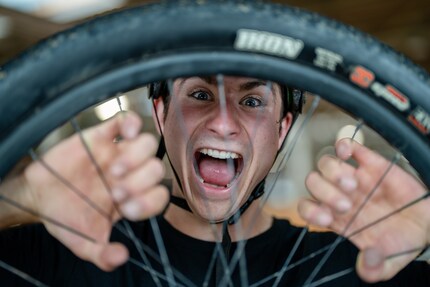
But the three guys make the job easier, and not just when it comes to the portraits. What I noticed above all about Lucas is that he shows initiative and asks what works for us. Communication with the athletes is extremely important – you could view the session as a kind of team sport.
It’s not like I can shoot sportspeople all on my own now, but this afternoon I learned what I’d need to be able to do it.
My interest in IT and writing landed me in tech journalism early on (2000). I want to know how we can use technology without being used. Outside of the office, I’m a keen musician who makes up for lacking talent with excessive enthusiasm.
Interesting facts about products, behind-the-scenes looks at manufacturers and deep-dives on interesting people.
Show all